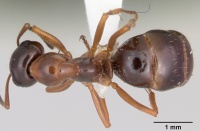Formica limata
| Formica limata | |
|---|---|

| |
| Scientific classification | |
| Kingdom: | Animalia |
| Phylum: | Arthropoda |
| Class: | Insecta |
| Order: | Hymenoptera |
| Family: | Formicidae |
| Subfamily: | Formicinae |
| Tribe: | Formicini |
| Genus: | Formica |
| Species: | F. limata |
| Binomial name | |
| Formica limata Wheeler, W.M., 1913 | |
This species nests under stones and logs, usually in exposed areas. Nests are occasionally small mounds in the soil. Nest populations are small, and these ants are timid. (Mackay and Mackay 2002)
Identification
Mackay and Mackay (2002) - The pronotum has fewer than 10 erect hairs (often none), and all surfaces are smooth and glossy. The scape is without erect hairs (except at the apex).
Distribution
United States: Montana and North Dakota, south to California and east to New Mexico.
Latitudinal Distribution Pattern
Latitudinal Range: 50.884° to 31.433333°.
| North Temperate |
North Subtropical |
Tropical | South Subtropical |
South Temperate |
- Source: AntMaps
Distribution based on Regional Taxon Lists
Nearctic Region: Canada, United States (type locality).
Neotropical Region: Mexico.
Distribution based on AntMaps
Distribution based on AntWeb specimens
Check data from AntWeb
Countries Occupied
| Number of countries occupied by this species based on AntWiki Regional Taxon Lists. In general, fewer countries occupied indicates a narrower range, while more countries indicates a more widespread species. |

|
Estimated Abundance
| Relative abundance based on number of AntMaps records per species (this species within the purple bar). Fewer records (to the left) indicates a less abundant/encountered species while more records (to the right) indicates more abundant/encountered species. |

|
Habitat
In New Mexico (Mackay and Mackay 2002) - Meadows and grasslands through sagebrush, pinyon-juniper, ponderosa pine-riparian, grassy areas up to the tree line.
Biology
For New Mexico (Mackay and Mackay 2002) - Brood was found in nests in August. One nest was found within a cave, 80 ft from the entrance. Workers are attracted to baits (grape jelly, tuna).
Association with Other Organisms
 Explore: Show all Associate data or Search these data. See also a list of all data tables or learn how data is managed.
Explore: Show all Associate data or Search these data. See also a list of all data tables or learn how data is managed.
- This species is a mutualist for the aphid Rhopalosiphum nymphaeae (a trophobiont) (Jones, 1927; Saddiqui et al., 2019).
Castes
Worker
Images from AntWeb
   
| |
| Worker. Specimen code casent0104881. Photographer April Nobile, uploaded by California Academy of Sciences. | Owned by CAS, San Francisco, CA, USA. |
Nomenclature
The following information is derived from Barry Bolton's Online Catalogue of the Ants of the World.
- limata. Formica (Proformica) limata Wheeler, W.M. 1913f: 541 (w.) U.S.A.
Description
References
- Mackay, W. P. and E. Mackay. 2002. The ants of New Mexico (Hymenoptera: Formicidae). Edwin Mellen Press, Lewiston, NY.
- Siddiqui, J. A., Li, J., Zou, X., Bodlah, I., Huang, X. 2019. Meta-analysis of the global diversity and spatial patterns of aphid-ant mutualistic relationships. Applied Ecology and Environmental Research 17: 5471-5524 (doi:10.15666/aeer/1703_54715524).
- Wheeler, G. C. and J. Wheeler. 1986. The ants of Nevada. Natural History Museum of Los Angeles County, Los Angeles.
- Wheeler, W. M. 1913i. A revision of the ants of the genus Formica (Linné) Mayr. Bulletin of the Museum of Comparative Zoology 53: 379-565 (page 541, worker described)
References based on Global Ant Biodiversity Informatics
- Allred D. M. 1982. Ants of Utah. The Great Basin Naturalist 42: 415-511.
- Allred, D.M. 1982. The ants of Utah. Great Basin Naturalist 42:415-511.
- Beck D. E., D. M. Allred, W. J. Despain. 1967. Predaceous-scavenger ants in Utah. Great Basin Naturalist 27: 67-78
- Bestelmeyer B. T., and J. A. Wiens. 2001. Local and regional-scale responses of ant diversity to a semiarid biome transition. Ecography 24: 381-392.
- Glasier J. R. N., S. Nielsen, J. H. Acorn, L. H. Borysenko, and T. Radtke. 2016. A checklist of ants (Hymenoptera: Formicidae) of Saskatchewan. The Canadian Field-Naturalist 130(1): 40-48.
- Gregg R. E. 1946. The ants of northeastern Minnesota. American Midland Naturalist 35: 747-755.
- Gregg, R.T. 1963. The Ants of Colorado.
- Kannowski P. B. 1956. The ants of Ramsey County, North Dakota. American Midland Naturalist 56(1): 168-185.
- La Rivers I. 1968. A first listing of the ants of Nevada. Biological Society of Nevada, Occasional Papers 17: 1-12.
- Mackay W. P., and E. E. Mackay. 2002. The ants of New Mexico (Hymenoptera: Formicidae). Lewiston, New York: Edwin Mellen Press, 400 pp.
- Mackay, W., D. Lowrie, A. Fisher, E. Mackay, F. Barnes and D. Lowrie. 1988. The ants of Los Alamos County, New Mexico (Hymenoptera: Formicidae). pages 79-131 in J.C. Trager, editor, Advances in Myrmecololgy.
- Michigan State University, The Albert J. Cook Arthropod Research Collection. Accessed on January 7th 2014 at http://www.arc.ent.msu.edu:8080/collection/index.jsp
- Wheeler G. C., and E. W. Wheeler. 1944. Ants of North Dakota. North Dakota Historical Quarterly 11:231-271.
- Wheeler G. C., and J. Wheeler. 1986. The ants of Nevada. Los Angeles: Natural History Museum of Los Angeles County, vii + 138 pp.
- Wheeler J. N., G. C. Wheeler, R. J. Lavigne, T. A. Christiansen, and D. E. Wheeler. 2014. The ants of Yellowstone National Park. Lexington, Ky. : CreateSpace Independent Publishing Platform, 2013. 112 pages.
- Wheeler, G.C. and J. Wheeler. 1988. A checklist of the ants of Montana. Psyche 95:101-114
- Wheeler, G.C. and J. Wheeler. 1988. A checklist of the ants of Wyoming. Insecta Mundi 2(3&4):230-239
- Wheeler, G.C., J. Wheeler, T.D. Galloway and G.L. Ayre. 1989. A list of the ants of Manitoba. Proceedings of the Entomological Society of Manitoba 45:34-49

